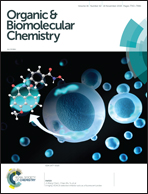Sulfono-γ-AA modified peptides that inhibit HIV-1 fusion†
Abstract
The utilization of bioactive peptides in the development of highly selective and potent pharmacological agents for the disruption of protein–protein interactions is appealing for drug discovery. It is known that HIV-1 entry into a host cell is through a fusion process that is mediated by the trimeric viral glycoprotein gp120/41, which is derived from gp160 through proteolytic processing. Peptides derived from the HIV gp41 C-terminus have proven to be potent in inhibiting the fusion process. These peptides bind tightly to the hydrophobic pocket on the gp-41 N-terminus, which was previously identified as a potential inhibitor binding site. In this study, we introduce modified 23-residue C-peptides, 3 and 4, bearing a sulfono-γ-AA residue substitution and hydrocarbon stapling, respectively, which were developed for HIV-1 gp-41 N-terminus binding. Intriguingly, both 3 and 4 were capable of inhibiting envelope-mediated membrane fusion in cell–cell fusion assays at nanomolar potency. Our study reveals that sulfono-γ-AA modified peptides could be used for the development of more potent anti-HIV agents.

- This article is part of the themed collection: Chemical Biology in OBC


 Please wait while we load your content...
Please wait while we load your content...